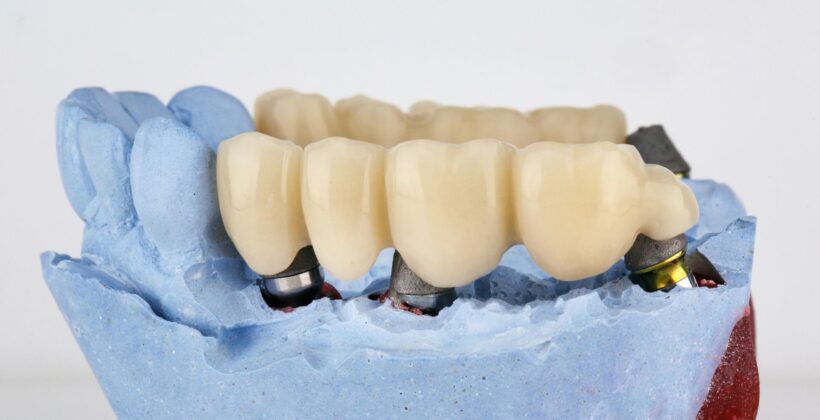
Many terms and phrases pop up regarding oral health. While devices like braces are common knowledge, others are not as well known. One of those is dental bridges. What is a bridge in dentistry?
Dental bridges are an effective and reliable solution for replacing missing teeth when maintaining a healthy and complete smile. Missing teeth can affect your ability to chew, speak, and confidently smile. Fortunately, dental bridges offer a way to restore the function and appearance of your teeth.
What is a Dental Bridge in Dentistry?
So, what is a dental bridge in dentistry? A dental bridge is a denture that replaces one or more missing teeth. As the name suggests, it “bridges” the gap left by a missing tooth by attaching the false tooth (or teeth) to adjacent natural teeth or dental implants
Dental bridges restore the aesthetics and functionality of your smile, allowing you to chew and speak properly.
How Does a Dental Bridge Work?
A dental bridge typically consists of two main components:
Abutments: The teeth on either side of the gap support the bridge. They are usually prepared by removing a portion of the enamel to accommodate the crowns placed on them.
Pontics: The false teeth that fill the gap are called pontics. They are attached to the abutments and can be made from various materials, including porcelain, gold, alloys, or a combination of these.
Types of Dental Bridges
There are several types of dental bridges available, each suited to different situations and patient needs:
Traditional dental bridges: This is the most common type of bridge and requires either a crown for a tooth or a filling on both sides of a missing tooth, with a pontic in between. Traditional bridges are stronger and more durable, making them suitable for patients having natural teeth on either side of the gap.
Cantilever bridges: These are used when adjacent teeth are on the same side of a missing tooth or teeth. The pontic is placed on one or more adjacent teeth. However, this bridge is inexpensive and can be recommended in specific cases where the pressure on the bridge is relatively low.
Maryland-bonded bridges: Also known as resin-bonded bridges, this type uses a metal or porcelain framework bonded behind adjacent teeth. Although this is a more conservative option because it does not require teeth nearby, it removes more expensive and generally less dense enamel in the inner edge areas. It may not be suitable for those with higher bite forces.
Implant-supported bridges: These are used when more than one tooth is missing. Dental implants are placed in each missing tooth, and the bridge is then attached to these implants. Implant-supported bridges are stable and do not require adjacent natural tooth support, making them ideal for patients with multiple missing teeth.
Benefits of Dental Bridges
Now that we’ve discussed what is a bridge in dentistry, let’s take a look at its benefits. Getting a dental bridge can offer numerous benefits, including:
Restored Functionality: Missing teeth can make chewing and speaking difficult. A dental bridge restores these functions, allowing you to enjoy your favourite foods and speak clearly.
Improved Aesthetics: A bridge fills the gap left by missing teeth, giving you a complete and natural-looking smile. This can significantly boost your confidence and make you feel more comfortable in social situations.
Preventing Teeth Shifting: When a tooth is missing, the adjacent teeth may shift into the space, leading to misalignment and bite problems. A bridge helps maintain the proper alignment of your teeth.
Maintaining Facial Structure: Missing teeth can lead to a sunken appearance in the cheeks and jaw area, making you look older. By filling in the gaps, a dental bridge helps maintain the natural shape of your face.
Long-Lasting Solution: With proper care, dental bridges can last for many years. They are a durable and cost-effective solution for replacing missing teeth.
The Dental Bridge Procedure
If you’re considering getting a dental bridge, here’s what you can expect during the procedure:
Initial Consultation: Your dentist will thoroughly examine your teeth and gums, take X-rays, and discuss your options for replacing the missing tooth or teeth. They will help you choose the type of bridge that best suits your needs.
Preparation: During the first visit, the abutment teeth are prepared by removing a portion of the enamel to make room for the crowns. Impressions of your teeth are then taken, which will be used to create a custom bridge that fits perfectly in your mouth. A temporary bridge may be placed to protect the exposed teeth and gums while your permanent bridge is being made.
Placement: Once your custom bridge is ready, you’ll return to the dentist for placement. The temporary bridge is removed, and the new bridge is carefully fitted and adjusted for comfort and function. Once everything is in place, the bridge is permanently cemented to the abutment teeth.
Follow-Up Care: After the bridge is placed, your dentist will instruct you on how to care for it. Good oral hygiene is essential to maintaining the longevity of your bridge, so be sure to brush and floss regularly. Regular dental checkups are also important to ensure that your bridge remains in good condition.

Midland Bay Dental: Your Trusted Dental Experts
If you’re asking, “What is a bridge in dentistry?” You’ve found the experts you need. At Midland Bay Dental, we’ve been providing dental services in the Midland, Ontario, area since 1974. We have helped countless patients achieve the smiles of their dreams.
We pride ourselves on providing expert family dentistry. We offer dental crowns and bridges, regular cleaning and checkups, and more intensive procedures like tooth replacement, cosmetic dentistry, and teeth whitening.
Contact Midland Bay Dental to book an appointment online or call us at (705) 526-6441.
Follow Midland Bay Dental on Facebook.

Leave a Reply